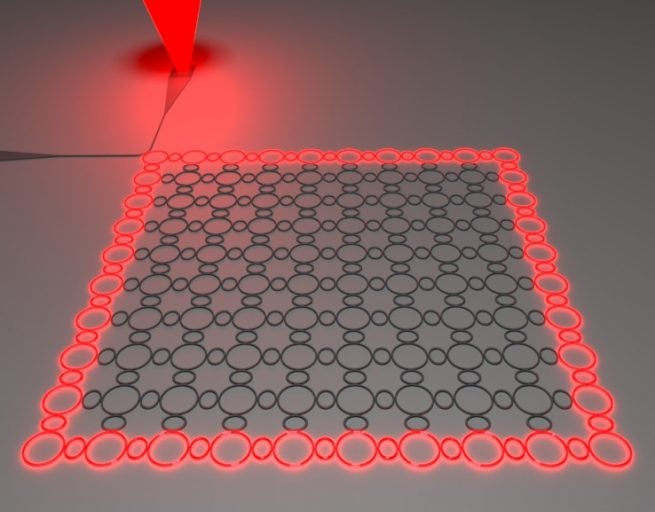A team of optics researchers at the University of Central Florida has demonstrated a new laser technology that has the potential to substantially improve the efficiency, beam quality, and resilience of semiconductor laser arrays.
The results of the “nonmagnetic topological insulator laser” are presented in two research papers in Science, one describing the theory of topological lasers and the other outlining experiments.
The project was led by Professors Mercedeh Khajavikhan and Demetrios Christodoulides of the College of Optics and Photonics and their graduate students Steffen Wittek, Midya Parto and Jinhan Ren in conjunction with a team from Technion – Israel, which includes Moti Segev, Miguel Bandres and Gal Harari. The theoretical component of the work was initiated by the Technion team, while the experimental part was carried out at UCF’s Center for Research and Education in Optics and Lasers, one of the college’s research centers.
The teams were interested in solving a long-standing problem in laser physics that perplexed scientists for the past 40 years: how to create a high-power, ultimately focusable, and single frequency semiconductor laser array that does not lose efficiency even when its sub-elements fail or malfunction. Such a laser is expected to find applications in numerous areas of science and technology. The answer to this problem came from a rather unexpected place.
“We were inspired by the developments in topological insulator materials,” said Christodoulides. “It was less than two years ago that the Nobel Prize in Physics was awarded to the theoretical physicists whose work established the role of topology in understanding these exotic forms of matter.”
Topological insulators are one of the most innovative and promising areas of physics in recent years, providing new insight into the basic understanding of protected transport. These are special materials that conduct a “super-current” on their surface while being insulators in their interior. The current on the surface is not affected by defects, sharp corners or disorder; it continues unidirectionally without being scattered. Two years ago, the team wondered if there could be a way to utilize notions from topological science into laser physics. This could lead to altogether new families of lasers with improved performance characteristics.
The team decided to build a topological insulator for photons, which is a challenging task since photons, unlike electrons, do not have a charge. Moreover, magnetic fields do not substantially affect semiconductor light-emitting materials.
“To solve these problems, we came up with clever designs to trick photons to feel as if they are experiencing a magnetic field and having a spin,” said Khajavikhan, the lead experimentalist. The team used an array of microring resonators that are arranged in such a way to mimic the presence of a magnetic field. By pumping only the rings on the periphery of the array, they excited the laser to emit in the topological edge mode. This mode, traveling along the edge, can most efficiently use all the available pump power to generate a coherent, single-mode, high power beam.
The study leads to a new class of active topological photonic devices that could be readily integrated with sensors, antennas and other photonic devices. The work demonstrated that not only are topological insulator lasers theoretically possible and experimentally feasible, but also marked the first practical application using such topological principles in optics.
“There is a great pleasure to see how a line of fundamental research can address such tangible and practical problems,” Christodoulides said.
Learn more about Optical Engineering and Photonics Research Programs at UCF.
